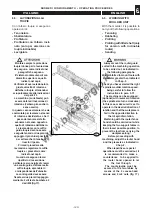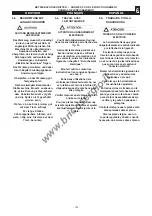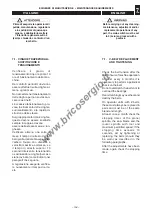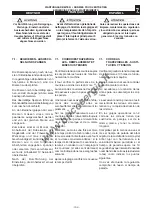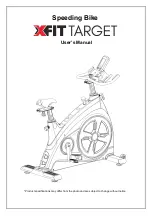
6.
NORME DI FUNZIONAMENTO • OPERATING PROCEDURES
ENGLISH
ITALIANO
-
142
-
Tenonatura
La tenonatura è una fresatura di
testa (a traverso di vena) che vie-
ne effettuata per ottenere incastri
fra tenone maschio
M
(fig. 18) e
tenone femmina
F
.
Eseguire questa operazione con il
carro scorrevole, montando l’ap-
posito pianetto a tenonare
A
(fig. 19).
Utilizzare l'apposita cuffia per
tenonare
C
.
Agire sui pomelli
D
e regolare le
protezioni
E
e
F
in modo da copri-
re al massimo l'utensile.
Nella versione con battute revesibili
(fig.20) sostituire il paraschegge
H
come descritto nel cap.4 "montag-
gio pianetto a tenonare".
Bloccare sempre il pezzo
utilizzando il pressore in
dotazione.
La lavorazione di tenonatura va
eseguita esclusivamente con la
velocità di rotazione dell'albero
di 3500/4000 giri/min.
Per un migliore assemblaggio nel-
lo strettoio occorre:
– regolare la profondità dei tenoni
maschio 0,5 mm inferiori alla lar-
ghezza del montante (fig. 21);
– regolare la profondità dei tenoni
femmina 0,5 mm inferiori alla lar-
ghezza del traverso (fig. 21).
Tenoning
Tenoning is a head milling
operation (against the grain) which
is carried out to obtain joints
between male tenons
M
(Fig. 18)
and female tenons
F
.
Carry out this operation with sliding
table after fitting additional table
A
(fig. 19).
Use the appropriate tenoning hood
C
.
Act on the knobs
D
and adjust the
protections
E
and
F
so that they
cover the tool as much as
possible.
In the version with reversible stops
(fig. 20) substitute the chip guard
H
as described in chapter 4
“tenoning and table assembly".
Always lock the piece using the
presser provided.
Tenoning must exclusively be
carried out with a spindle rotation
speed of 3500/4000 rpm.
For a better assembly:
– adjust the tenon depth 0,5 mm
less than the jamb width (fig. 21);
– adjust the slot depth 0,5 mm less
than the crosspiece width
(fig. 21).
40_071_0.tif
18
21
63_067_0.tif
033.008.0.tif
20
H
033.040.0.tif
•
•
E
•
D
C
A
F
19
www.bricosergio.it













